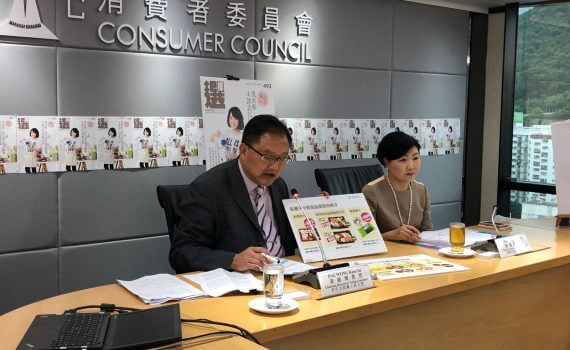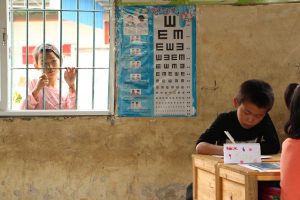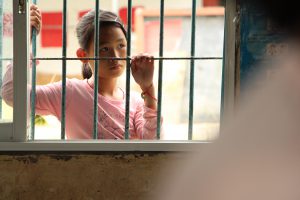Somewhere over the rainbow - How an 8-year-old boy experience China's education gulf
- By: Caroline KwokEdited by: Cecilia Wong
- 2017-12-30
Every morning at 8:30, the muddy ocher-coloured cottage is blasted with young voices reading aloud textbook passages, so loud that it can be heard across the cement-levelled playground far from the school gate.
There are three classrooms in the cottage with no lights but a rickety ceiling fan each. Drawings are repeatedly glued on and ripped off a section of the wall framed with red rice paper. On top, it wrote sloppily "In Celebration of the June First International Children's Day".
This is where the eight-year-old Huang Wei-biao goes to school every day with his 22 young schoolmates, a village in the rural area of the East Guangxi province. The nearest town is 45 minutes of serpentine car ride away.
One can tell Huang is a diligent student as he reads his textbook with his finger precisely pointing at each word when he pronounces it. One can tell Huang is an assiduous child as the veins of his neck appear every time he utters a word. One can tell Huang is an eager learner as each page of his textbook is torn and curled at the corners.
Yet no matter how earnest or smart a student Huang is, he is just one the 13.8 million village primary students in China who are probably receiving education of lower quality than students who study in the urban parts of China.
Village schools lack facilities and professionally trained teachers. Pupils do not have classes in other areas such as arts and physical education, let alone school outings.
In comparison, the XinXing primary school in the same prefectural city has a multi-story building with a sports ground. There are more than 40 teachers and most of them have received tertiary education.
Children's' parents can also find better working opportunities close by and not have to leave their sons and daughters to their grandparents since the school is located in downtown area.
The two teachers in Huang's school, who both did not graduate with any kinds of certificates of education, are in charge of all three classes of the school. They do not know enough English to give students English classes so village children would learn English if they were lucky enough to be able to make it to secondary school in main cities.
This June, Huang received his first English lesson from a group of Hong Kong volunteer teachers. He picked an English name for himself, Jim.
Huang's two elder brothers were not as lucky. Not only do they find difficulties catching up with English in their junior high school years, their parents, who went to the cities for work, were missing from most of their childhood.
Nicknamed Little Little Star, 25, has been a village teacher in the Qinglong Manzu Primary School in Hubei province of China for two years.
She said village schools are most deprived of human resource instead of hardware or other school facilities.
"There are computers in the school where I worked at but there were not many teachers...teachers with better education qualities also wish to stay in the cities," she said.
She said provinces allocate resources according to the economic development of the county or provincial city and the school's reputation. Meaning fewer resources are allocated to educating students living in less developed cities.
Some schools would want to retain better-performing students who can be admitted to more renowned secondary schools or universities because higher university admission rate can boost the school's reputation and, in turn, their allocated teaching resources, she said.
There would be a vicious cycle of not being able to cultivate outstanding students who can perform well in nation-wide examinations due to lack of resources in the first place.
Universities in China generally have equal admission standards for secondary students regardless of where they study but due to differences in teaching resources, university students mainly come from better-established urban schools, she said.
"It is frustrating indeed," Little Little Star said.
She said some families with better financial support would send their children to study in the cities.
"Equity is being kept at best effort but China is too big and there is no way to guarantee fairness for everyone," she said.
There are a few university graduates who are alumni of Huang's primary school. Huang wants to be an inventor in the future. He wants to invent robots who can help his parents do chores. He would need knowledge from the university.
It would be a pity if students like Huang who pays attention to writing every stroke of the Chinese character could not enter university because he did not have a head start in education.
Wang Dan, associate professor of faculty of education in University of Hong Kong, said there is quite a large education gulf between rural and urban regions but the disparity has been greatly narrowed down in the past ten years, especially in terms of hardware.
Wang said there might still be a relatively large variance in terms of students' academic performances and discrepancy in professional teacher training remains the largest challenge.
Ten years ago, most of the teachers in villages are graduates from technical secondary schools, which is equivalent to senior high school education level but now, they are at least, two-year diploma holders or even university degree holders, Wang said.
"Though the number (of university graduate village teachers) is small, it is still a significant improvement for village schools," the professor said.
On a management level, village schools do not or cannot provide adequate in-service vocational training to their teachers hence affecting students' academic performance, Wang said.
On a national level, China also started to waiver tuition fees and accommodation fees for rural children since 2007, Wang added.
Wang said China can further improve remuneration structure of village teachers to increase their incentives to teach in rural areas or circulate teachers between different areas.
The education gap is not the cause of urban-rural gap, instead, it is the opposite… the rural community should be built-up first in order to retain pupils, professionals, talents and in turn contribute to sustainable development of the community, Wang said.
"The first batch of talents who are willing to stay behind at villages must be willing to sacrifice a bit… there must be reasons for them to stay such as education ambitions and sense of belonging," Wang said.
The village crisis could potentially endanger China's general future but the education gap has not hinder China's development in the past, Wang said.
"Villages underwent enormous changes", the professor said.
To get to the town nearest to Huang's school from Shenzhen used to take about eight hours before railways and roads leading to the town were built. Now, the travel distance is shortened to about four hours.
China's education gulf seems deterring but it is only about four hours and 677 km away.
Chong Chuen Yung, who has been to six volunteering trips in China organized by Dandelion Project have witnessed some of the worse classroom conditions.
"We once walked for an hour up a mountain in Guangxi Province to get to a school with no electricity and we have to help students have their lessons using flashlight from our mobile phones," she said.
She said though village students are often very determined and resolved, they are limited to a very small worldview and lack of directions in life.
"We wish to introduce them the bigger world, and the other side of the world," Chong said.
The Hong Kong teachers who visited Huang's school put him into playgroups and they played all kinds of games in physical education class, drew pictures with his finger in arts class.
It was a new teaching method very different from his usual school days when he and his classmates sit in separate rolls and learn by recitations.
He knew all his group mates have their own favourite colour so he picked "rainbow" as the name for his group. He knew he wants to be an inventor so that he can make robots to help his parents do the chores. He knew he has to study hard so he writes each Chinese character so prudently that his workbook looks strangely neat.
But would he know if his dreams really do come true somewhere over the rainbow with a gulf underneath?

《The Young Reporter》
The Young Reporter (TYR) started as a newspaper in 1969. Today, it is published across multiple media platforms and updated constantly to bring the latest news and analyses to its readers.

Food Order Platforms Price Markup Up to 86%

Children of asylum seekers deprived of education rights in Hong Kong

















Comments